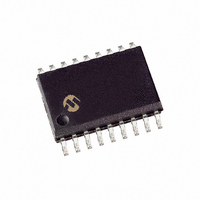PIC16F84A-20I/SO Microchip Technology, PIC16F84A-20I/SO Datasheet - Page 398

PIC16F84A-20I/SO
Manufacturer Part Number
PIC16F84A-20I/SO
Description
IC MCU FLASH 1KX14 EE 18SOIC
Manufacturer
Microchip Technology
Series
PIC® 16Fr
Datasheets
1.PIC16F688T-ISL.pdf
(688 pages)
2.PIC16F84A-04P.pdf
(88 pages)
3.PIC16F84A-04P.pdf
(6 pages)
Specifications of PIC16F84A-20I/SO
Core Size
8-Bit
Program Memory Size
1.75KB (1K x 14)
Core Processor
PIC
Speed
20MHz
Peripherals
POR, WDT
Number Of I /o
13
Program Memory Type
FLASH
Eeprom Size
64 x 8
Ram Size
68 x 8
Voltage - Supply (vcc/vdd)
4 V ~ 5.5 V
Oscillator Type
External
Operating Temperature
-40°C ~ 85°C
Package / Case
18-SOIC (7.5mm Width)
Controller Family/series
PIC16F
No. Of I/o's
13
Eeprom Memory Size
64Byte
Ram Memory Size
68Byte
Cpu Speed
20MHz
No. Of Timers
1
Processor Series
PIC16F
Core
PIC
Data Bus Width
8 bit
Data Ram Size
68 B
Maximum Clock Frequency
20 MHz
Number Of Programmable I/os
13
Number Of Timers
8
Operating Supply Voltage
2 V to 5.5 V
Maximum Operating Temperature
+ 85 C
Mounting Style
SMD/SMT
3rd Party Development Tools
52715-96, 52716-328, 52717-734
Development Tools By Supplier
ICE2000
Minimum Operating Temperature
- 40 C
Lead Free Status / RoHS Status
Lead free / RoHS Compliant
For Use With
I3-DB16F84A - BOARD DAUGHTER ICEPIC3309-1075 - ADAPTER 18-SOIC TO 18-SOIC309-1011 - ADAPTER 18-SOIC TO 18-DIP309-1010 - ADAPTER 18-SOIC TO 18-DIPDVA12XP080 - ADAPTER DEVICE FOR MPLAB-ICEAC164010 - MODULE SKT PROMATEII DIP/SOIC
Data Converters
-
Connectivity
-
Lead Free Status / Rohs Status
Details
Available stocks
Company
Part Number
Manufacturer
Quantity
Price
Company:
Part Number:
PIC16F84A-20I/SO
Manufacturer:
AD
Quantity:
670
- Current page: 398 of 688
- Download datasheet (3Mb)
PICmicro MID-RANGE MCU FAMILY
21.11
21.12
21.13
DS31021A-page 21-14
Use of the CCP Trigger
Connection Considerations
Transfer Function
An A/D conversion may be started by the “special event trigger” of a CCP module. This requires
that the CCPxM3:CCPxM0 bits (CCPxCON<3:0>) be programmed as 1011 and that the A/D
module is enabled (ADON bit is set). When the trigger occurs, the GO/DONE bit will be set, start-
ing the A/D conversion, and the Timer1 counter will be reset to zero. Timer1 is reset to automat-
ically repeat the A/D acquisition period with minimal software overhead (moving the ADRES to
the desired location). The appropriate analog input channel must be selected and the minimum
acquisition done before the “special event trigger” sets the GO/DONE bit (starts a conversion).
If the A/D module is not enabled (ADON is cleared), then the “special event trigger” will be
ignored by the A/D module, but will still reset the Timer1 counter.
If the input voltage exceeds the rail values (V
of the conversion is out of specification.
An external RC filter can sometimes be added for anti-aliasing of the input signal. The R compo-
nent should be selected to ensure that the total source impedance is kept under the 10 k rec-
ommended specification. Any external components connected (via hi-impedance) to an analog
input pin (capacitor, zener diode, etc.) should have very little leakage current at the pin.
The ideal transfer function of the A/D converter is as follows: the first transition occurs when the
analog input voltage (V
Figure 21-6: A/D Transfer Function
AIN
) is 1 LSb (or Analog V
FEh
FFh
04h
03h
02h
01h
00h
Analog input voltage
SS
or V
REF
DD
/ 256)
) by greater than 0.3V, then the accuracy
(Figure
1997 Microchip Technology Inc.
21-6).
Related parts for PIC16F84A-20I/SO
Image
Part Number
Description
Manufacturer
Datasheet
Request
R

Part Number:
Description:
Manufacturer:
Microchip Technology Inc.
Datasheet:

Part Number:
Description:
IC MCU FLASH 1KX14 EE 18DIP
Manufacturer:
Microchip Technology
Datasheet:

Part Number:
Description:
IC MCU FLASH 1KX14 EE 18SOIC
Manufacturer:
Microchip Technology
Datasheet:

Part Number:
Description:
IC MCU FLASH 1KX14 EE 18DIP
Manufacturer:
Microchip Technology
Datasheet:

Part Number:
Description:
IC MCU FLASH 1KX14 EE 18SOIC
Manufacturer:
Microchip Technology
Datasheet:

Part Number:
Description:
IC MCU FLASH 1KX14 EE 18DIP
Manufacturer:
Microchip Technology
Datasheet:

Part Number:
Description:
IC MCU FLASH 1KX14 EE 18DIP
Manufacturer:
Microchip Technology
Datasheet:

Part Number:
Description:
IC MCU FLASH 1KX14 EE 20SSOP
Manufacturer:
Microchip Technology
Datasheet:

Part Number:
Description:
IC MCU FLASH 1KX14 EE 18SOIC
Manufacturer:
Microchip Technology
Datasheet:

Part Number:
Description:
IC MCU FLASH 1KX14 EE 20SSOP
Manufacturer:
Microchip Technology
Datasheet:

Part Number:
Description:
IC MCU FLASH 1KX14 EE 20SSOP
Manufacturer:
Microchip Technology
Datasheet:

Part Number:
Description:
IC MCU FLASH 1KX14 EE 20SSOP
Manufacturer:
Microchip Technology
Datasheet:

Part Number:
Description:
IC MCU CMOS 4MHZ 1K FLASH 18-DIP
Manufacturer:
Microchip Technology
Datasheet:

Part Number:
Description:
IC MCU CMOS 20MHZ 1K FLASH 18DIP
Manufacturer:
Microchip Technology
Datasheet:

Part Number:
Description:
IC MCU CMOS 4MHZ 1K FLASH 18SOIC
Manufacturer:
Microchip Technology
Datasheet:











